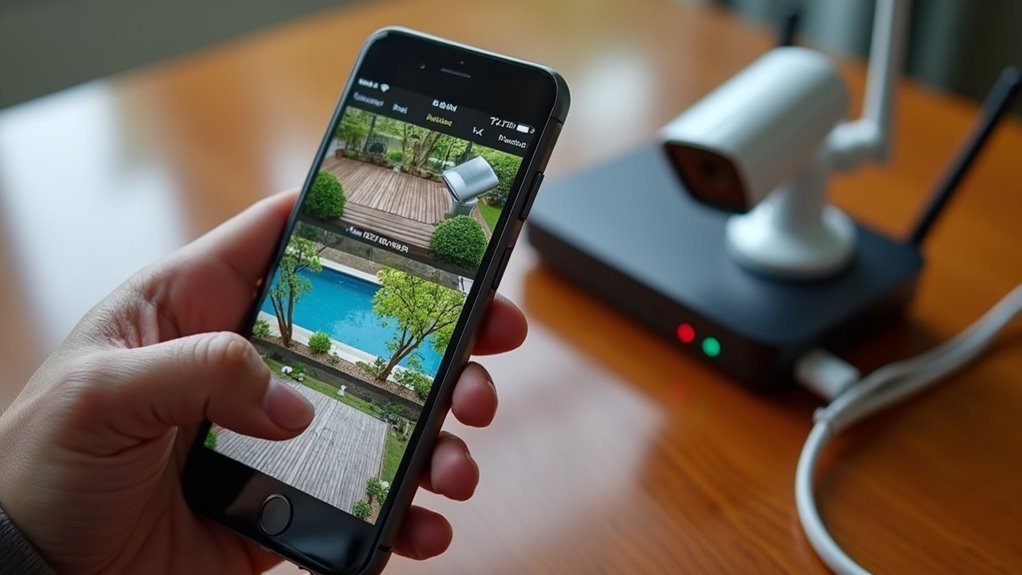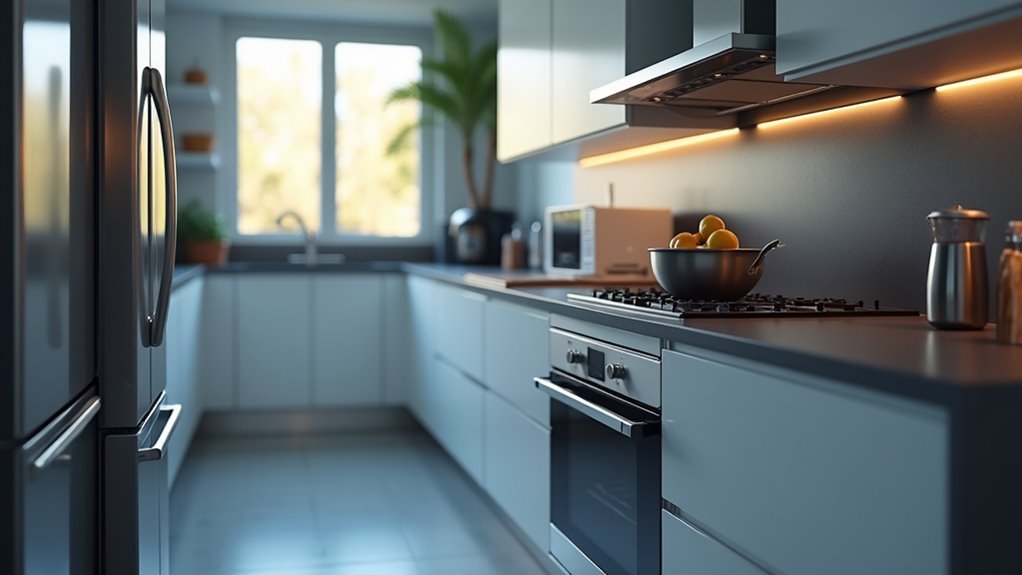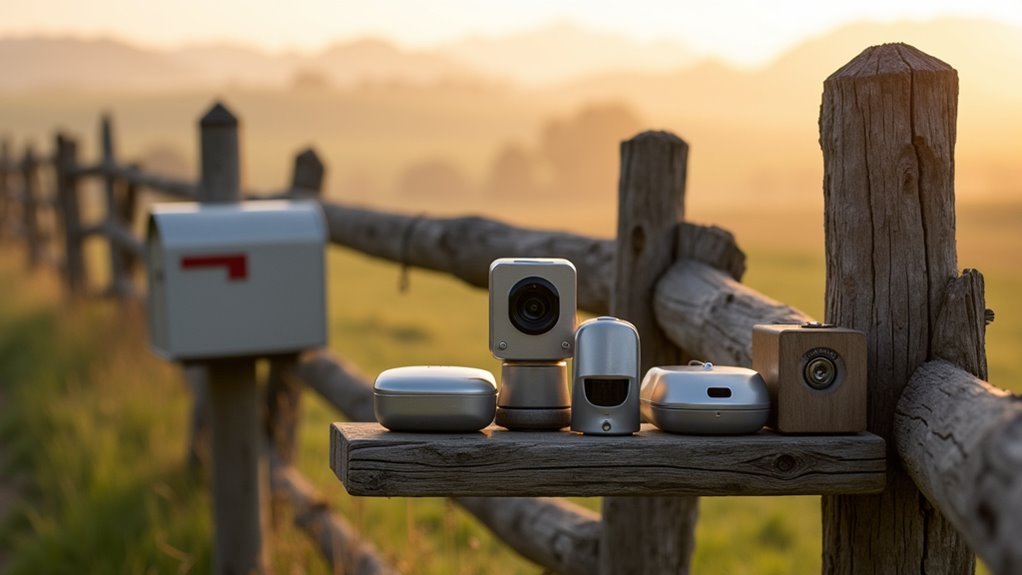You’re probably unaware that your smart home devices are constantly transmitting your personal data to corporate servers, creating detailed profiles of your daily habits and routines. While cloud-based systems offer convenience, they’ve turned your private sanctuary into a data goldmine for tech giants. There’s a powerful alternative that puts you back in control—local processing hubs that keep everything within your four walls, but the shift isn’t as straightforward as you might expect.
Understanding Local Processing Vs Cloud-Based Smart Home Systems

Privacy Matters greatly in this choice.
Local processing keeps your personal information within your home’s walls, while cloud systems often harvest your data for analytics and third-party purposes.
Your personal data stays private at home instead of being collected and sold by cloud-based companies.
You’ll also find greater customization with local hubs like Home Assistant and Hubitat Elevation, compared to cloud systems that limit you to predefined settings.
Though local processing requires higher initial investment, you’ll avoid ongoing subscription fees and maintain complete data sovereignty.
Privacy Benefits of Keeping Your Data at Home
When you process smart home data locally, you’re creating a digital fortress that keeps your most intimate information—from daily routines to security footage—locked safely within your home’s network boundaries.
The privacy benefits of local processing are substantial:
- Complete data ownership – You control what’s shared and with whom, eliminating third-party service provider risks
- Reduced breach exposure – No cloud storage means hackers can’t access your data through external servers
- Zero external policies – Your data isn’t subject to changing privacy policies or corporate misuse
- Enhanced security – Offline systems face fewer hacking attempts than cloud-connected devices
With 81% of consumers worried about smart home data collection, local processing addresses these legitimate privacy concerns while maintaining full home automation functionality.
Essential Hardware Requirements for Local Processing Hubs

Storage is essential—invest in an SSD or HDD with minimum 32GB capacity for software and device logs.
Your network infrastructure matters equally; choose a quality router supporting Z-Wave and Zigbee protocols for seamless device communication.
Protocol compatibility determines your home hubs’ effectiveness.
Confirm your hardware supports multiple communication standards including Z-Wave, Zigbee, and Wi-Fi to maximize device compatibility and integration possibilities across manufacturers.
Home Assistant: Open-Source Privacy Champion
You’ll find Home Assistant stands as the gold standard for privacy-focused home automation, building its entire architecture around local processing and zero mandatory cloud dependencies.
Its open-source foundation lets you integrate thousands of devices directly through your home network, keeping your data under your complete control.
The platform’s community-driven development model guarantees you’re getting continuous updates and new features while maintaining the core philosophy that your smart home data belongs to you alone.
Privacy-First Architecture Design
Unlike cloud-dependent smart home systems that funnel your personal data through corporate servers, Home Assistant’s privacy-first architecture guarantees every piece of information stays within your home’s boundaries.
This design philosophy assures your smart home devices communicate exclusively through local processing, eliminating external data exposure.
The platform’s architecture revolves around four core privacy principles:
- Zero Cloud Dependencies – All automation logic runs locally on your hardware
- Encrypted Local Communications – Device interactions use secure protocols within your network
- User-Controlled Data Storage – You decide what information gets stored and where
- Transparent Code Base – Open-source foundation allows complete security auditing
Your Raspberry Pi or dedicated server becomes the central command center, processing every sensor reading and automation trigger without ever reaching external servers.
Local Device Integration
Connecting over 2,000 different device types through standardized protocols, Home Assistant transforms your collection of smart gadgets into a unified ecosystem that operates entirely within your local network.
You’ll achieve seamless local device integration through Z-Wave, Zigbee, and Wi-Fi protocols, eliminating the need for multiple manufacturer apps and cloud dependencies.
The platform’s YAML-based configuration system lets you create sophisticated smart home automation workflows tailored to your specific needs.
You can customize everything from simple lighting schedules to complex multi-device scenarios that respond to environmental changes or user behaviors.
When you encounter integration challenges, the community-driven support network provides extensive documentation and troubleshooting resources.
This collaborative approach guarantees you’ll maintain complete control over your devices while maximizing their functionality within your privacy-focused smart home infrastructure.
Community-Driven Development Model
Behind this extensive integration capability lies Home Assistant’s community-driven development model, where thousands of contributors actively shape the platform’s evolution.
You’ll benefit from real user feedback that drives continuous improvements, ensuring the software meets actual home automation needs rather than corporate agendas.
This community-driven development approach delivers several advantages for your local processing setup:
- Rapid bug fixes – Issues get identified and resolved quickly by active users
- Feature requests – You can directly influence what gets built next
- Security patches – Multiple eyes reviewing code enhance your privacy protection
- Documentation updates – Real users create guides based on practical experience
You’re not just using software; you’re part of an ecosystem where your privacy needs directly influence development priorities, keeping local processing capabilities at the forefront.
Hubitat Elevation: User-Friendly Local Control
Simplicity drives Hubitat Elevation’s design philosophy, making local smart home control accessible to users regardless of their technical expertise.
You’ll find setup straightforward, with an intuitive interface that eliminates complex programming requirements. Unlike cloud-dependent smart home hubs, Hubitat’s local processing guarantees your devices respond instantly while maintaining privacy through on-premise data handling.
You can connect Z-Wave, Zigbee, and LAN devices seamlessly, creating a versatile smart home ecosystem.
The platform’s rule engine lets you build sophisticated automations without coding knowledge. During internet outages, your smart home continues functioning normally since everything runs locally.
Regular software updates enhance security and performance automatically. You’ll experience reduced latency, improved reliability, and complete control over your smart home data—all while enjoying user-friendly operation that doesn’t compromise on powerful automation capabilities.
Setting Up Your Offline Smart Home Network

While cloud-based systems dominate the smart home market, you can build a completely offline network that operates independently of internet connectivity.
Creating this autonomous system requires strategic planning and proper device selection to guarantee seamless local control of your smart devices.
Strategic device selection and careful planning form the foundation of any successful autonomous smart home system.
Here’s your step-by-step setup process:
- Configure a dedicated router specifically for your smart home network, isolating it from your main internet connection.
- Install Z-Wave and Zigbee devices that communicate directly with your local hub without requiring cloud services.
- Set up a Network Video Recorder (NVR) for security cameras to store footage locally on-site.
- Establish your control hub like Home Assistant or Hubitat Elevation as the central command center.
This approach guarantees complete privacy while maintaining full automation functionality.
Compatible Devices That Work Without the Cloud
Once you’ve established your offline network foundation, selecting the right devices becomes essential for maintaining complete independence from cloud services.
Compatible devices like Z-Wave and Zigbee sensors communicate directly with your hub, eliminating cloud dependency for door/window sensors and motion detectors.
Smart thermostats with local API access, such as the Ecobee SmartThermostat, operate independently without internet connections.
Local network cameras providing RTSP streams maintain complete privacy over your footage.
Home Assistant and Hubitat Elevation serve as excellent local processing hubs, integrating diverse compatible devices for fully offline environments.
When choosing smart bulbs, select Zigbee or Z-Wave options like Philips Hue White bulbs that don’t require cloud accounts, ensuring your lighting system maintains offline functionality while preserving your privacy.
Z-Wave and Zigbee: The Foundation of Local Communication
Two wireless protocols form the backbone of truly independent smart home networks: Z-Wave and Zigbee.
These specialized protocols enable your devices to communicate locally without requiring cloud connectivity, ensuring your privacy remains intact.
Z-Wave operates on sub-1GHz frequencies, delivering extended range and minimal interference, while Zigbee uses 2.4GHz for faster data transmission and expanded mesh capabilities.
Both create self-healing networks where devices relay signals to strengthen your entire system.
Key advantages of these protocols include:
- Local operation – Functions continue during internet outages
- Mesh networking – Each device extends network range and reliability
- Scalability – Z-Wave supports 232 devices, Zigbee handles hundreds
- Direct hub communication – No cloud dependency for automation
You’ll maintain complete control over your smart home ecosystem with these foundational technologies.
Securing Your Local Smart Home Infrastructure
Building your local smart home network requires implementing multiple layers of security to protect against potential vulnerabilities.
Start by selecting a local control hub like Home Assistant or Hubitat that processes data on-site, eliminating cloud dependencies. Strengthen your network with robust passwords for devices and Wi-Fi, and consider VPN protection against external threats.
Keep firmware and software updated regularly to patch vulnerabilities and enhance security features.
Choose Z-Wave or Zigbee sensors operating on local mesh networks rather than Wi-Fi devices requiring constant internet connectivity. Monitor your network continuously using scanning apps to detect suspicious activity and verify only authorized devices connect to your smart home ecosystem.
These measures create extensive protection for your locally-controlled home automation system.
Advanced Automation Without Internet Dependency
While cloud-based smart homes falter during internet outages, local processing hubs like Home Assistant and Hubitat Elevation execute sophisticated automation sequences entirely within your home network.
Your advanced automation continues functioning regardless of internet connectivity, responding instantly to triggers like motion detection or temperature fluctuations.
Local automation hubs maintain full functionality during internet outages, delivering instant responses to environmental changes and motion sensors.
These systems deliver extensive control through:
- Z-Wave and Zigbee integration – Connect sensors, switches, and smart devices without internet dependency
- YAML-based configurations – Create complex automation rules using flexible scripting languages
- Visual interface options – Design automation flows through user-friendly drag-and-drop editors
- Zero-latency responses – Execute commands immediately without cloud communication delays
Local processing guarantees your automation rules operate seamlessly during outages while maintaining complete privacy of your sensitive home data.
Troubleshooting Common Local Processing Issues
Why do even the most robust local processing hubs occasionally stumble with device communication or automation failures?
Troubleshooting these issues starts with verifying device compatibility with your local hub, as unsupported hardware creates connectivity problems. You’ll need to regularly update firmware on both your hub and connected devices to fix bugs and enhance security.
Check your network’s stability and bandwidth since slow connections disrupt device communication.
Use your hub’s built-in diagnostics tools and community forums for troubleshooting guidance—they’re goldmines for solutions based on real user experiences.
When automation delays occur, optimize your configuration by reducing simultaneous commands or simplifying complex scripts. This improves your local hub’s processing efficiency and prevents bottlenecks that slow down your smart home operations.
Migrating From Cloud-Based to Local Systems
Although cloud-based smart home systems offer convenience, you’ll gain greater privacy, reliability, and control by moving to local processing hubs. This move requires careful planning to maintain functionality while achieving true local control.
Follow these essential steps for successful relocation:
- Select a compatible hub – Choose Home Assistant or Hubitat Elevation for robust local control capabilities.
- Replace cloud-dependent devices – Switch to Z-Wave and Zigbee devices that communicate locally without internet reliance.
- Backup existing configurations – Export your current automations and settings before changing over to preserve your smart home setup.
- Implement local storage – Install a Network Video Recorder (NVR) to keep security footage within your home environment.
Community forums provide valuable troubleshooting support throughout your relocation process, ensuring smooth changeover success.
Performance Optimization for Local Hubs
Once you’ve migrated to a local hub system, maximizing its performance becomes essential for maintaining the responsive, reliable smart home experience you’re seeking.
Local processing requires adequate hardware resources, so verify your hub has sufficient processing power and memory to handle multiple devices and complex automations simultaneously.
Implement regular firmware updates to maintain stability and access new features without external server dependencies.
Configure Z-Wave and Zigbee protocols for efficient device communication, minimizing interference across your network.
Set up device prioritization systems to guarantee critical functions execute promptly during peak usage periods.
Performance optimization involves streamlining local automations and organizing device hierarchies.
This approach ensures your hub delivers near-instantaneous responses while maintaining the privacy benefits you gained from abandoning cloud-based systems.
Future-Proofing Your Privacy-Focused Smart Home
You’ll need to plan for hardware that won’t become obsolete in three to five years, focusing on devices with strong community support and regular firmware updates.
Your protocol strategy should prioritize open standards like Z-Wave and Zigbee that’ll adapt to emerging technologies without forcing complete system overhauls.
Building redundant backup systems guarantees your smart home continues functioning even when primary components fail or manufacturers discontinue support.
Hardware Longevity Planning
While building your local processing home hub requires significant upfront investment, planning for hardware longevity guarantees you won’t face costly replacements or security vulnerabilities down the road.
Your smart home control system’s durability depends on making strategic hardware choices that’ll serve you for years.
Essential hardware longevity strategies:
- Choose robust platforms – Invest in Raspberry Pi or dedicated servers with proven reliability and strong component quality.
- Prioritize open-source support – Select devices with firmware that receives regular updates and security patches.
- Design modular systems – Build infrastructure allowing easy component swaps without complete overhauls.
- Plan incremental upgrades – Regularly assess and upgrade RAM or storage to prevent obsolescence as automation demands grow.
Energy-efficient components reduce operational costs while maintaining peak performance throughout your system’s extended lifespan.
Protocol Evolution Strategies
Smart home protocols change rapidly, and your carefully planned hardware investment means nothing if tomorrow’s communication standards leave your devices stranded.
Protocol evolution strategies center on choosing devices that support multiple communication standards like Zigbee, Z-Wave, and Thread. Matter’s emergence exemplifies how industry standards shift toward interoperability, reducing manufacturer lock-in while enhancing user control.
Your local processing hub should embrace open standards rather than proprietary solutions. This approach guarantees broader device compatibility as protocols evolve.
Regular software updates for your hub maintain security and functionality without cloud dependency, adapting to new features seamlessly.
Prioritize devices with local processing capabilities to mitigate risks from planned obsolescence and service discontinuations.
Multi-protocol support creates a resilient ecosystem that survives manufacturer changes and protocol changes.
Backup System Design
Because hardware failures and data corruption strike without warning, establishing robust backup system design becomes essential for maintaining your privacy-focused smart home’s continuity.
Your local processing setup requires thorough protection strategies that don’t compromise your data sovereignty.
Implement these critical backup components:
- Network Attached Storage (NAS) – Store automations, configurations, and data locally without cloud dependencies
- Secondary Control Hub – Deploy a Raspberry Pi failover system for critical functionality continuity
- Uninterruptible Power Supply (UPS) – Maintain operations during power outages with redundant power systems
- Regular Testing Schedule – Verify restoration processes work efficiently and all components recover seamlessly
You’ll protect your privacy-focused ecosystem while ensuring quick recovery from any system failure through methodical backup planning.
Frequently Asked Questions
Can Local Hubs Integrate With Existing Cloud-Based Smart Home Insurance Discounts?
You’ll likely lose cloud-based insurance discounts when switching to local hubs since insurers can’t access your usage data. However, you can contact your provider to discuss alternative verification methods for maintaining discounts.
Do Local Processing Hubs Affect Home Resale Value or Buyer Interest?
You’ll likely increase your home’s resale value with local processing hubs. Tech-savvy buyers appreciate privacy-focused smart home systems, and you’re demonstrating forward-thinking home automation that doesn’t rely on cloud services.
How Much Do Electricity Costs Increase When Running Local Hubs Continuously?
You’ll see electricity costs increase by $5-15 monthly when running local hubs continuously. Your actual costs depend on your hub’s power consumption, local electricity rates, and usage patterns. Most modern hubs consume 10-50 watts.
Can Guests Easily Control Smart Home Features Without Cloud Account Access?
You’ll need to create guest access through your local hub’s interface or mobile app. Most hubs let you set up temporary user accounts or share device controls without requiring guests to have cloud-based accounts.
Are Local Hub Warranties Voided by Third-Party Hardware Modifications or Upgrades?
You’ll likely void your warranty if you modify hardware components or install unauthorized upgrades. Most manufacturers explicitly exclude coverage for tampering, opening cases, or adding third-party components to their devices.





Leave a Reply